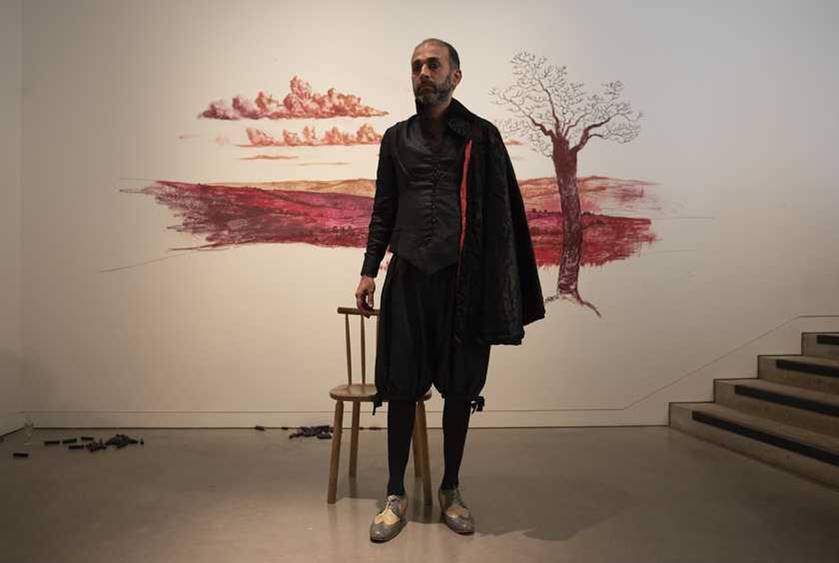Digvijay Nikam
What kind of relationship does the work of art bear with the artist’s body? Is the latter only an agent to aesthetic creation where the locus of any transformation is the art work and not the
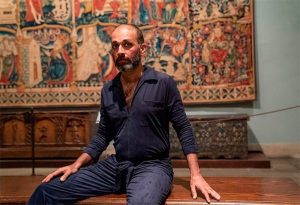
Courtesy- Metropolitan Museum of Art
body? The contemporary Indian artist Nikhil Chopra has tried to bridge this chasm by foregrounding the body at the centre of his artistic practice. Born in 1974 to a Kashmiri family in Kolkata, Chopra first completed a BFA at The Maharaja Sayajirao University of Baroda in 1999 and went on to do an MFA from Ohio State University in 2003. He was the 2019-2020 Artist in Residence at the prestigious Museum of Modern Art (MOMA) in New York, USA. In 2014 he founded the HH Art Spaces in Goa which has played a critical role in supporting and expanding the artistic domain in Goa.
Chopra’s artistic practice involves a creative amalgamation of durational performance, painting, drawing, sculpture, and photography in order to investigate issues pertaining to identity, politics, history, and the body. Even as a student enjoying working on the canvas at Baroda, the theatre interested him for its dynamic engagement with its live audience. He wanted to bring that sense of liveliness to his work as a painter, something that became possible only when he went to the US and got exposed to the vibrancy of performance art which brought his two passions together. This blending together, this messiness of form in performance art harbours, for Chopra, powerful transgressive and transformative energy that can unsettle the normative order of the day.
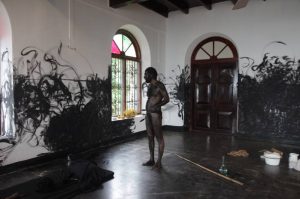
Courtesy of the artist and Chatterjee & Lal.
A typical Chopra performance includes him taking on the persona of a character – inspired by personal family history and broader national, regional, and colonial histories – for several hours or even days to produce paintings, drawings, and other objects that he thinks of as “residual components – the object legacy – of the performance.” Interestingly, during these extended stretches of performance, Chopra engages in both everyday actions of eating, washing, dressing, sleeping and the creation of artworks over which eventually his body becomes the canvas transformed by the detritus from the drawings, for example, the dust from the charcoal or the mud when used as a medium . He says the “labour is also the work: I like to show the slow unravelling of my process.”
For Nikhil, these performances are ways, not just for examining the questions of the outside world but simultaneously and sometimes more importantly, explorations of his own self and its history. The body for Chopra is a carrier of the familial past and a marker of multiple histories. His most reprised roles include Sir Raja—a figure loosely inspired by the affluent westernised Indian princes of the British Raj period and the artist’s own instilled upper-class sensibilities—and Yog Raj Chitrakar, who presents as a well-travelled, turn-of-the-century landowner and draughtsman, and is partially inspired by his grandfather.
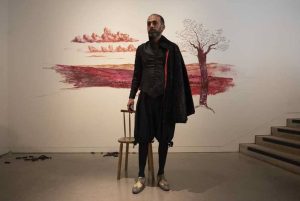
Courtesy- Neena Percy
Rouge is one of Chopra’s most exciting performances, first performed at Kettle’s Yard, Cambridge in 2019 in which he drew a large landscape on the gallery wall using different shades of red lipstick over a period of three hours. Wearing a heavy eyeliner and dressed in a corseted jacket, velvet cloak, tights, and heeled shoes, Chopra theatrical attire reminded one of an Elizabethan bard. Throughout the performance, he enacted gestures that referenced the English theatre, for instance, placing a hand on his hip and standing as if about to deliver a speech.
Catherine Wood, Senior Curator of International Art (Performance) at Tate has observed how Chopra’s positioning of himself in front of his landscape mural in a pose is reminiscent of Gainsborough’s portraits of British aristocracy where landscapes in paintings were markers of ownership, status, and power. Chopra’s figure in signifying the aspirations of that gentlemanly class for wealth invokes – and in doing that, critiques – the history of imperial rule and its colonization of foreign territories. The artist while talking about the performance in an interview also brought forth the development of studio photography at the turn of the century, where British photographers would photograph Indian dignitaries posed in front of studio landscapes, representing the Indian ruling class while signing off land to the British Crown. The performance ends with him stripping down to a loincloth, placing his cloths on a chair with his shoes resting neatly.
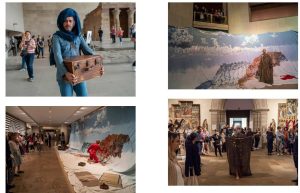
Courtesy- Metropolitan Museum of Art
Lands, Waters and Skies is the title of his performance that he performed in 2019 in the Metropolitan Museum of Art in New York City. In this 9-day performance, Chopra assumed various personas to create a large drawing measuring 58×20 feet on cotton fabric while spending time at different locations of the Museum, interrogating its collection of objects that span 20,000 years of human culture across six continents. Like a nomad, he travelled from one end of the Museum to the other, traversing space and time and collecting narratives while drawing different sections of his magnanimous painting – land, water, and sky – at different locations. The three elements carry deep significance in terms of connecting the disparate world that the museum is an embodiment of. Chopra says – “I am looking for the common thread that runs through all of us; hunger, thirst, love, lust, greed, anger, joy, pain, passion, sorrow, and fear. We are all physically connected to each other by land and water, living out our lives and our rainbow of emotions under one sky.”
Through his numerous other performances, Chopra has tried to explore other areas of Indian and global history intermingling them with the banalities of everyday existence. Presenting the transformative potential of performance art, he has stretched and complicated the understandings of theatricality, canvas, and their relation to the body.
Bibliography
- https://www.platform-mag.com/literature/an-important-movement.html
- https://www.tate.org.uk/research/research-centres/hyundai-tate-research-centre-transnational/event-report-nikhil-chopra
- https://acaw.info/?page_id=39349
- https://www.hindustantimes.com/more-lifestyle/performance-artist-nikhil-chopra-and-the-recipe-of-magic/story-kiHx3cwsEU5jJukPLWqXSK.html

